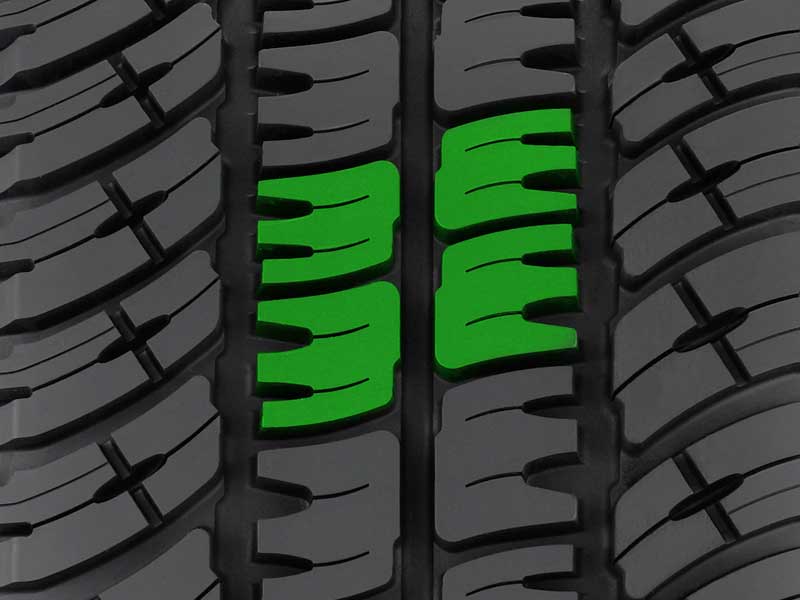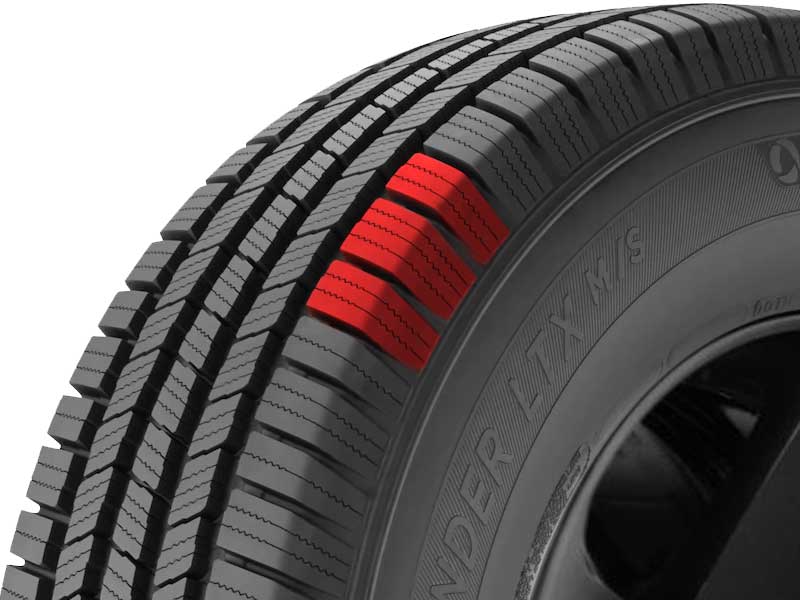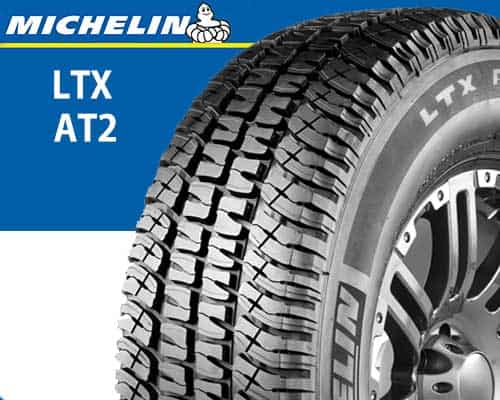Michelin’s LTX MS and LTX AT2 are both uniquely designed to handle different terrain types. Thanks to their Michelin Max Touch construction, these tires are built to last without sacrificing grip.
The LTX AT2 stands out with its superior off-road capabilities. However, when it comes to pavement performance, it falls a bit short compared to the LTX MS. This boils down to their respective designs.

Let’s dive deeper and see what each tire brings to the table
Table of Contents
Design of both tires
Starting with the Michelin LTX AT2 the tire features “W” shaped blocks on the two ribs here. These are actually notches that puts them with this shape, and they act as biting edges off road. See below, where they are highlighted with green color.
Michelin LTX A/T2

Michelin Defender LTX MS


All these blocks have reinforced foundations underneath in the form of a continuous rib.
And overall very minimal siping is seen here, especially when compared to LTX MS.
On the other hand, the Defender LTX MS offers a ton of interlocking full depth siping on 3 ribs which forms a total 4 circumferential channels (instead of 3 in LTX AT2).

All these channels are also joined by offset lateral grooves (which also provide groove notches).
If we move towards the shoulders, the LTX AT2 provides with a more aggressive design where the shoulder blocks are split up with slanted incisions with notches attached to them.

These blocks again lie on a continuous rib which provides foundation underneath.
And again, very little siping is seen here, just like its central blocks.
On the sidewalls, the shoulder lugs make a very combative design forming sharp edges.
On the other side, the Michelin Defender LTX MS provides with more siping in comparison (with same 3d interlocking pattern).
Here the blocks due to the tire’s symmetric design, vary in width.

These blocks also extend a little on the sidewall but don’t make any sidewall lugs like on AT2.
Furthermore, the blocks on their inner margins have offset edges (just like the middle blocks).
More design features of these tires:
| LTX MS | LTX AT2 | |
| Tread Depth (avg) | 12/32″ | 15.2/32″ |
| Weight (avg) | 38.8 lbs | 44.3 lbs |
| Width (avg) | 10.3″ | 10.2″ |
| Sizes | 15 to 22″ | 16 to 20″ |
Traction Comparison – On-Road
Although both of these tires provide you almost similar dry road performance, the Michelin LTX AT2 lacks a lot on wet roads.
The tire provides with very limited siping combined with harder compound.
So with the the stiffer rubber the tire does not provide siping flexibility to pump in and out the water particles beneath.
And there are very less sipes to begin with.
It’s sipes are also rectilinear and they don’t interlock, (which provide the blocks flexibility), and this also results in the tire’s poor traction here.
Furthermore, these sipes are also not deep enough and with 50% of the tire’s wear they are almost gone, leaving tire with lost wet traction values.
On the other side, the Defender LTX MS provide you with numerous 3D wave like siping that interlock during handling.
And with the tire’s softer compound, these sipes are more flexible to squeeze and flex sucking water in efficiently.
The tire is also better in terms of on road noise as it’s less wider grooves provide less air particles to hit the tread sides (which makes noise).
Furthermore, by weighing less in comparison, the tire also consumes less fuel in comparison.
Off-Road Performance Comparison
- Traction on Sand: 18% better in AT2.
- Traction on soft mud/snow: 20% better in AT2.
- Traction on hard snow: 4% better in LTX MS.
- Traction on rocks: 6% better in AT2.
Michelin Defender AT2, are off-road tires and comparatively they can handle all types of terrains better than LTX MS.
Traction on Sand
The deep biting edges on each block (see central part of tread) of Michelin Defender AT2 allow the tire to crawl its way through sand easily.

The notches on the shoulder blocks combined with its serrated sidewalls allow the tire to keep its grip while handling on sand.
The Michelin LTX, although is good enough for mild sand, would not be able to outperform its competitor here, as it does not provide as aggressive biting edges.
Traction on Rock
On rocks or gravels, again, the Michelin’s AT2 tire provides better reliability.
On bigger rocks, the biting edges and serrated sidewalls bite into the surface to ensure greater traction.
On smaller rocks/pebbles/gravel, the larger groove voids ensure that no traction is lost as they are tossed out of the tire easily.
The larger voids also cause a sticky effect on bigger rocks, where the tread blocks can move in all directions. This also makes the tire absorb bumps and the overall off road comfort is enhanced.
The Michelin LTX MS on the other hand would feel more bumpy on rocks. At times the tire lost traction on small rocks as well.
It was however able to do a lot better on bigger rocks. This has to do with lots of sipes seen on the tire. They bite the surface for traction.
Traction on Soft Terrains
Deeper grooves and aggressive design of Michelin AT2 allows the tire easy passage through mud as it cuts through it, throwing it backwards.
The inner and outer shoulders act as paddles and the substantial sipes ensure that friction remain intact with the mud.
Larger groove voids traps more mud inside, which is also another edge this tire has over the LTX MS.
The Michelin LTX MS just can’t compete here. The sipes on the tire may help it a bit but in deeper mud, the tire is going to loose traction. And it’s not recommended for it too.
Same is true for soft snow.
But for hard snow, smaller groove voids and sipes are required for better traction. That’s why the LTX MS is better here.
Tread Wear and Durability
Tread wear mostly depend on your driving style and the path the tire mostly stay on.
For example, if LTX MS tires are used off road, they would wear off rather quickly.
In a same way if the Michelin AT2s would wear off quicker on road.
Still both tires offer very good durability and tread life.
The Michelin LTX MS offers 70k miles warranty. And the AT2 offer 60k miles.
And both these tires can run up to 50-60k miles on average easily.
Summing up
Both are great tires made for different purposes.
If you are planing to mostly stay on road then you should definitely go with LTX MS. These tires are very comfortable. They provide excellent traction on both dry and wet conditions, are are very efficient in terms of fuel consumption.
However, if your tires are going to stay off road most of the time, we recommend the Defender AT2. They would not disappoint you at all.
They are very durable and their aggressive design ensure better traction on all types of terrains.


